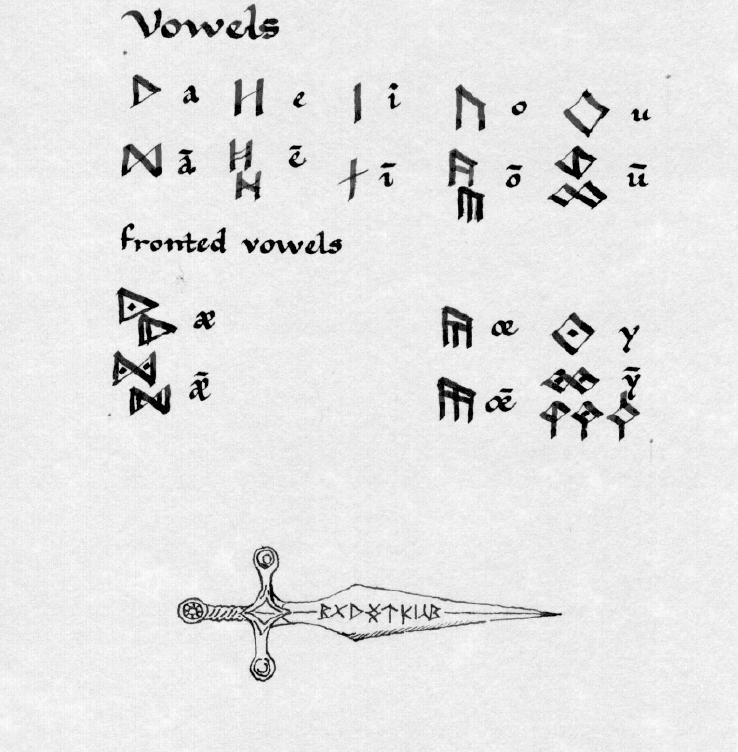This form of runes, while superficially similar to other runic systems such as the Angerthas or the Anglo-Saxon runes, has a unique relationship between the shapes of the letters and the sounds. Noticeable in this system is the use of diamond shapes which make it look different from other rune systems. Almost all that we know of the Gondolinic Runes was published by Paul Nolan Hyde in Mythlore, No. 69, in the summer of 1992. For information on the original publication check out unpublished and slightly published manuscripts and scroll down to the bottom for how to order back issues of Mythlore. I give here a chart based on that information.


Interestingly enough, it has not been possible to determine exactly which language Tolkien had in mind when he produced this alphabet. The letters do not match the pattern of phonemes of any of the languages we might expect, such as the languages of Middle-earth or the Indo-European languages of the real world. However, the phoneme system is fairly close to Old English, though it is not clear what they needed with unvoiced n. Since Gondolin was known for the learning of the linguists who lived there, it may be that the alphabet was designed to be used for notating a variety of languages. The alphabet is quite sufficient for writing English, however. For that purpose, I include a list here of the pronunciation of some of the less obvious sounds.
New info: There is a font for these runes now, available from Ronald Krymse's website at www.geocities.com/otsoandor/Gondolin_Font.htm. This is a very interesting website with lots of information about Tolkien's alphabets. Thanks to Glorfindel Ellachor for the link!
Here is a little pronunciation guide for native speakers of English (non-linguists)
ch in church
j in judge
sh in shush
zh in azure
th in thick, thin
dh in the, this
h in house
X in either Bach or possibly as the gh in Anglo-Saxon lagu which is a voiced velar fricative (not found in English)
ng in sing
mh, ngh, rh, lh are unvoiced versions of the consonants m, ng, r, l respectively (not found in modern English)
hw as in which, when pronounced the old-fashioned way
hy in huge, Hugh
ks or x as in fox
Vowels,
a in father
ae sound in cat
e in they
i in machine
o in boat
oe in German Goethe (ö), not found in English but similar to the e sound in Gertie if you don't pronounce the r very strongly.
u in boot
y sound in as German müssen, not found in English but similar to the sound in eeuuwww!!
These sounds may be long or short, meaning that the long versions take twice as long to say as the short ones.
There is no known example by Tolkien of the use of the Gondolinic Runes, however we find an apparent reference to their use in The Hobbit. Tolkien describes the swords which Bilbo, Gandalf and the dwarves find in the troll hoard, "Two [swords] caught their eyes particularly, because of their beautiful scabbards and jeweled hilts." The swords are much too fine to be the product of trolls, but Gandalf is unable to read the inscriptions and says, "when we can read the runes on them we shall know more about them," [Chapter on Roast Mutton]. Later in Rivendell the swords are shown to Elrond because "Elrond knew all about runes of every kind." He tells them that "They are old swords, very old swords of the High Elves of the West, my kin. They were made in Gondolin for the Goblin-wars," and he then reads their names "Glamdring" for the sword which Gandalf has chosen, and "Orcrist" for the sword of Thorin [Chapter on A Short Rest]. While runes of Gondolin are never mentioned again, Gandalf retains his sword Glamdring into the Lord of the Rings, where it appears "girt at his side" in the chapter "The Ring goes South."
Return Home.
Tyalie Tyelellieva / LisaStar@earthling.net / written January 2002